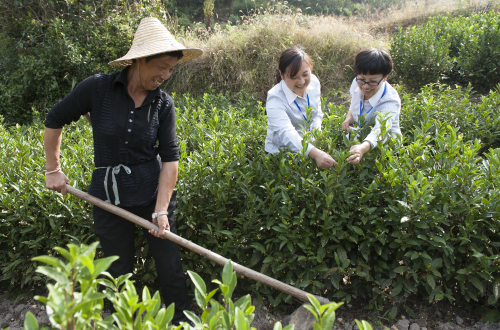|
 |
|
PUTTING GREEN TOWARD GREEN: Clerks from a rural credit cooperative in Jingning County, Zhejiang Province, help a local tea farmer in the field after discussing a loan arrangement (LI SUREN) |
Liu Tianhua, a farmer in Zhoukou, central China's Henan Province, established Tianhua Farming Specialized Cooperative in his hometown in 2009. The cooperative now operates 733 hectares of farmland, with fixed assets exceeding 20 million yuan ($3.19 million). "My greatest wish in 2015 is favorable weather and more supportive policies," Liu said.
Liu's cooperative has evolved into a comprehensive farming entity, the business of which encompasses planting, land transfer, warehousing, processing of agricultural products, lease of agricultural machinery and technical assistance.
"In 2014, rural reforms were carried out in steady steps," said Chen Xiwen, Deputy Director of the Central Rural Work Leading Group, which is China's top agency in charge of rural work and agricultural affairs. He stressed that authorities have pushed reforms regarding pricing policies for some crops, registration and confirmation of farmers' rights to their contracted lands, transfer of land use rights and transformation to large-scale farming.
On February 1, the Central Committee of the Communist Party of China and the State Council, China's cabinet, jointly released their first policy document in 2015, informally known as the No.1 Document. Modern farming and rural reform are high on its agenda. Since 2004, issues concerning agriculture, rural areas and farmers have been the focus of central authorities' No.1 documents for 11 years in a row.
Compared to double-digit expansion over the past few decades, the Chinese economy has entered a "new normal" of moderate and more stable growth. Chen said that the economic growth slowdown has exerted an influence on supply and demand as well as fiscal revenue of the government, which will undoubtedly pose a new challenge to agricultural development.
He believes the "new normal" will also have a positive impact. "Under the 'new normal,' attention will be shifted from GDP and output growth to the quality and efficiency of economic development and production, which will create a propitious atmosphere for the transformation of agricultural development model, the improvement of production structure and the integration of the agricultural, manufacturing and service industries," Chen said.
Highway to modernization
China's grain output hit 607.1 million tons in 2014, up 0.9 percent year on year; its rural per-capita net income stood at 989 yuan ($158), an increase of 9.2 percent after adjusting for inflation, according to statistics from the National Bureau of Statistics. The income of rural residents grew faster than that of urban residents.
While great achievements have been made in agricultural development, the pressure to do more lingers.
"Equal emphasis should be laid on elevating output, quality and efficiency," said Han Jun, Deputy Director of the Office of the Central Rural Work Leading Group.
Chen noted that the greatest challenges to agricultural development now come from rising production costs and a deteriorating ecological environment.
Currently, production costs of major agricultural crops in China are higher than imports. "Since China has a huge population engaged in agriculture and household-based farming is usually small-scaled, it is difficult to lower production costs," Chen said.
As was stressed during the Central Rural Work Conference held at the end of last year, registration and confirmation of farmers' rights to their contracted lands should be accelerated and transfer of land use rights should be encouraged to develop large-scale farming.
"In the past, China's agricultural development was resource-intensive. To balance the importance of quantity, quality and efficiency, efforts should be made to propel scientific and technological progress and raise farmers' awareness of modern farming techniques," Han said.
According to statistics from the Ministry of Agriculture (MOA), the contribution rate of science and technology to agricultural development has reached 57 percent in China, and the country's comprehensive agricultural mechanization rate has surpassed 60 percent. Farmlands managed by large-scale farming entities, such as family farms and farmers' cooperatives, have accounted for roughly one third of the total contractual lands.
China needs a new agricultural management system and new operating entities are encouraged to develop various forms of large-scale farming, says the No.1 Document. According to statistics from the MOA, there have been 870,000 family farms and 1.21 million farmers' cooperatives in China, which have greatly boosted efficiency of agricultural production.
| 